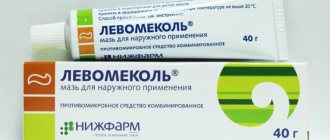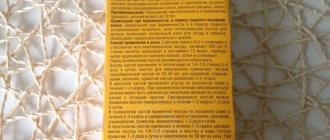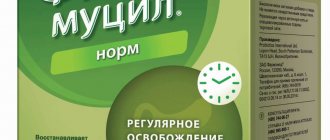During pregnancy, almost every woman encounters such an unpleasant phenomenon as swelling of the legs, pain and heaviness in them, as well as other manifestations of varicose veins. This is due to the fact that the heart cannot cope with the increased volume of blood, and the growing fetus compresses some vessels, which leads to venous stagnation. The situation is aggravated by the fact that the list of medications approved for use during this period is very limited.
However, there are medications that can alleviate the condition of the expectant mother and prevent the development of serious complications. So, doctors often prescribe Troxevasin ointment during pregnancy. How effective and safe is this drug and how to use it correctly so as not to harm the baby?
Composition and properties of the drug
The main active component of Troxevasin ointment (gel) is troskerutin. Accumulating in the endothelial layer of small blood vessels (venules) and penetrating deep into the venous network, this substance prevents oxidation and damage to cell membranes. Auxiliary components - carbomer, disodium salt, triethanolamine, benzalkonium chloride, purified water. Regular use of the drug provides:
- normalization of vascular circulation;
- increasing the tone of venous vessels, preventing their fragility;
- relief of inflammatory processes in vascular walls;
- improvement of metabolic processes in tissues;
- elimination of heaviness in the legs and cramps;
- reduction of swelling of the lower extremities.
Another unpleasant disease that pregnant women often encounter is hemorrhoids. If external hemorrhoids have been identified, then the use of this remedy will help to significantly reduce the inflammatory process and swelling in this area. The nodules will decrease in size, and along with them the pain will disappear. At the same time, you should not rely only on the miraculous properties of the medicine. Prevention of hemorrhoids, including a balanced diet rich in plant fiber, prevention of constipation, and daily walking, is mandatory for everyone.
Note! Together with Troxevasin gel, the doctor may prescribe capsules of the same name as a combination therapy, which is not contraindicated during pregnancy.
Troxevasin gel is often mistakenly called ointment. By and large, terminology in this case does not matter much. The only advantage of gels over ointments is the absence of fatty components, due to which the product is easy to apply, quickly absorbed, does not leave marks on the skin or clothing, and is also quickly washed off.
The best means
Depending on the active components, ointments and products are divided into groups:
- Venotonic . The most extensive group, including drugs with horse chestnut extract, troxerutin, prednisolone. The drugs strengthen the walls of blood vessels, prevent their ruptures, and make the venous network less noticeable. Phlebotonics relieve heaviness and prevent night cramps.
- Blood thinners . Includes components that improve blood flow and prevent thrombosis: heparin, diosmin, hesperdin. Drugs included in this group are contraindicated for hemophilia and other blood diseases.
- Anti-inflammatory . Nonsteroidal drugs that prevent edema, thrombophlebitis and thrombosis. Relieves pain and heaviness, improves lymph flow. Contains diclofenac, indomethacin and other components. Can be used together with drugs from other groups.
- Calming . This category includes light water-based creams and gels. The drugs have analgesic, decongestant, softening and regenerating effects. Contains hyaluronic acid, dextpanthenol, lidocaine, extracts of mint, lemon balm, chamomile.
- Heparin ointment for varicose veins during pregnancy is indispensable at any stage and can be used for prevention.
Prevents thrombophlebitis and thrombosis, strengthens vein walls, improves blood flow.
The main active ingredient is heparin. The product is not absorbed into the blood or breast milk and does not have a harmful effect on the fetus.
The ointment is applied to the affected areas in a thin layer and rubbed in gently.
Make 2-3 applications a day; it is especially useful to apply the product before bed.
Hepatrombin . A popular drug for strengthening blood vessels and improving blood supply to the extremities.
Contains prednisolone and heparin, is quickly absorbed.
Suitable for the treatment of the initial and middle stages of varicose veins, copes well with heaviness, pain, and night cramps. Venasol Plus . Light regenerating, decongestant, soothing cream. Contains dexpanthenol and herbal extracts.
Can be applied to skin 2 times a day after shower. The drug has a mild analgesic effect, relieves itching and flaking of the skin. Anti-varicose relaxing cream from the series “Recipes of Grandmother Agafya” . The composition includes horse chestnut extract, lemon balm and meadowsweet.
Soothes, prevents swelling, improves vascular function. Can be applied to the entire body, there are no contraindications for use. Cream-wax “Zdorov” . A preparation with a dense and rich texture, created on the basis of beekeeping products.
Contains natural wax, resin, propolis, bee venom, deadhead and moth extract.
Applied to affected areas, relieves pain, swelling, inflammation, soothes and tones.
Not suitable for people who are allergic to honey and other bee products.
Now you know what to apply to your legs for varicose veins during pregnancy, but are there any contraindications for these drugs?
Read also: How to do a contrast shower for varicose veins
Is it safe to use Troxevasin during pregnancy?
It is quite natural that every expectant mother, caring for the health of her unborn child, is wary of most medications. According to doctors, the use of this drug in gel form does not pose any danger to the woman and the developing fetus. Therefore, you can use Troxevasin throughout your pregnancy, regardless of the period, following the recommendations of your doctor and the instructions for the drug.
As for Troxevasin in capsules, they are prescribed to pregnant women no earlier than after 12 weeks - before this period it is extremely undesirable to take any medications unless there are serious indications for it.
Advice! It is necessary to understand that the success of treatment with this drug is closely related to the initiation of therapy. Troxevasin is considered a so-called “light” medicine, therefore, while coping with the initial manifestations of venous stagnation, it is practically powerless in advanced pathologies. Therefore, if you experience any discomfort in the lower extremities, you need to coordinate your actions with your doctor as soon as possible and begin therapy.
Indications and contraindications for use
Troxevasin ointment during pregnancy is indicated for use in the following cases:
- venous insufficiency;
- prevaricose syndrome;
- external or deep varicose veins of the lower extremities;
- superficial thrombophlebitis, as well as phlebitis or post-phlebitis conditions;
- hemorrhoidal disease (in the form of complex treatment);
- swelling and pain resulting from varicose veins or any injuries;
- convulsive contraction of the calf muscles.
Note! If swelling of the lower extremities is caused by pathologies of the kidneys, heart or liver, then this drug will not relieve the problem.
Contraindications to the use of Troxevasin are considered to be individual intolerance to any of the constituent components, the presence of open wounds or eczematous areas on the skin.
Reviews from women
Due to the prevalence of varicose veins of the legs during pregnancy, Troxevasin is used quite often. On the Internet you can read many reviews about this drug, which characterize it as an effective remedy for swelling, pain and cramps, varicose veins, and hemorrhoids. But there are also women for whom Troxevasin did not help get rid of their problems.
Troxevasin is a well-proven drug that helps cope with venous insufficiency and related problems. A gel prescribed by a doctor, as monotherapy or in combination with taking capsules of the same name, will support the health of the blood vessels of the expectant mother without causing harm to the baby.
Mode of application
According to the instructions for use, Troxevasin gel should be applied to the skin of the affected area twice a day - morning and evening, and then rubbed in with light massage movements.
In most cases, the treatment course lasts one month, but taking into account the course and severity of the disease, the doctor will recommend a different individual application.
When treating hemorrhoids, the drug is applied either directly to the protruding node, or it is used to soak gauze folded several times and leave it on the sore spot overnight.
Attention! It is strictly forbidden to apply ointment to mucous membranes or damaged skin. Under no circumstances should the gel be placed into the anus - it is intended only for the treatment of external hemorrhoids.
Analogs
If Troxevasin is not suitable for a pregnant woman, she may be recommended to use other drugs that are similar in their effects. Such analogues have some application features that are important to know about:
- Troxerutin is available in the form of capsules or gel for external use. Strictly prohibited in the first 12 weeks of pregnancy, as well as during breastfeeding. At a later date, its use is possible under the supervision of the attending physician.
- Troxegel is a drug whose main contraindications include individual sensitivity, as well as the first trimester of pregnancy and lactation. Since no scientific studies have been conducted on its use by pregnant women, it can only be used as prescribed by a doctor who will assess all possible risks to the mother and fetus.
- Lyoton is a gel that is used only under strict medical supervision, since the list of contraindications for its use is very large. These include increased sensitivity to the main active substance (heparin), threat of miscarriage, recent childbirth, severe neurological, vascular, renal, liver pathologies, as well as some diseases of the gastrointestinal tract.
- Hepatrombin gel is a fairly effective product that is well tolerated. It can be used no earlier than 5–6 months of pregnancy. If there is a need for earlier use of this drug, then the decision on its advisability should be made only by the doctor leading the pregnancy.
- Troxevasin-Neo is a gel consisting of a combination of troxerutin, heparin and despanthenol. There are no significant contraindications for use during pregnancy.
In conclusion, I would like to say that pregnancy is not the best time for self-medication and conducting various kinds of experiments. Considering that not only her health, but also the health of the unborn baby depends on the condition of the expectant mother, any, even the most minimal, discomfort must be reported to your doctor. It is he, and not the pharmacist at the pharmacy or experienced girlfriends, who will prescribe the most suitable drug and its dosage and thereby protect the patient’s legs from the risk of serious pathologies in the future.
Reasons for appointment
Side effects during treatment with Troxevasin rarely develop. When using capsules, these may be:
- nausea;
- diarrhea;
- heartburn;
- erosive and ulcerative lesions of the gastrointestinal tract;
- headache;
- flushes of blood to the face;
- allergic reactions (skin rash).
The gel may cause dermatitis and urticaria. According to the FDA (Food and Drug Administration - a government organization subordinate to the US Department of Health), no studies have been conducted on the effects of vitamin P on a pregnant woman or fetus, and no hazard class has been established.
Indications for the use of Troxevasin vary depending on the form of release.
Although the list of indications for the gel does not mention hemorrhoids, if hemorrhoidal cones are present, they are treated by applying gauze bandages soaked in the drug.
If a pregnant woman has diabetes, then Troxevasin can be prescribed as a preventive measure. This disease significantly increases the likelihood of problems with veins during pregnancy.
Troxevasin can be prescribed either alone or in combination with other venotonic drugs. In addition, only one dosage form or both at once may be recommended for treatment to obtain a faster therapeutic effect.
Indications for prescribing Troxevasin are:
- Varicose veins, including hemorrhoids;
- Thrombophlebitis in its acute stage;
- Hematomas;
- Trophic ulcers and dermatitis caused by chronic venous insufficiency and diabetes mellitus;
- Inflammation of the tissue surrounding the vein (periphlebitis);
- Moreover, the drug is used both for the treatment and prevention of these conditions.
Contraindications for taking Troxevasin are:
- Individual intolerance;
- Peptic ulcer of the stomach and duodenum in the acute phase;
- First trimester of pregnancy;
- Do not use the gel on areas with an open wound surface.
According to experts, venous insufficiency and thrombophlebitis lead to increased blood viscosity, which can cause clots and blockage of blood vessels. This is fraught with poor blood supply to the organs, which means that the embryo will not fully receive oxygen and nutrients. The lack of therapy is fraught with serious pathologies in the development of the fetus, so the expectant mother absolutely requires treatment.
During pregnancy, the doctor may prescribe the drug from the second trimester for:
- night cramps in the calf muscles;
- pain and feeling of heaviness in the legs;
- swelling of the lower extremities;
- hemorrhoids;
- pain syndrome of a traumatic nature (sprains, dislocations);
- the appearance of a venous network on the thighs and legs;
- pain and the appearance of blood during bowel movements;
- diabetes mellitus;
- overweight.
The pharmaceutical industry produces Troxevasin in two types:
- gelatin capsules for internal use, 300 mg;
- 2% gel for external use in tubes of 40 g.
In addition, in the pharmacy chain you can find Troxevasin Neo, which contains additional components:
- heparin - promotes the restoration of damaged tissues;
- dexpanthenol - cools the skin, makes it softer, improves the absorption of heparin.
Side effects resulting from the use of Troxevasin are rare. This mainly happens if there is individual intolerance to the components of the remedy. They appear as:
- allergies (hives, itching, rash);
- headache (in rare cases);
- nausea;
- diarrhea;
- heartburn;
- rush of blood to the face.
Usually these symptoms disappear immediately after stopping the drug.
Venous insufficiency increases the viscosity of the blood, which causes the formation of clots and blockage of blood vessels, due to which the organs are poorly supplied with blood, which means the baby in the womb does not receive enough oxygen and nutrients. If appropriate measures are not taken, problems can lead to severe pathologies in the development of the fetus, so pregnant women need to carefully monitor their health and promptly treat any illnesses.
The use of Troxevasin during pregnancy is justified only if the expected benefits cover the possible risks to the fetus. Used exclusively as directed by a physician.
During the period of an “interesting” situation, the doctor may prescribe a remedy from the second trimester for:
- pain and heaviness in the legs;
- hemorrhoids;
- swelling of the legs;
- the appearance of a venous network on the legs and thighs;
- diabetes mellitus;
- excess body weight;
- cramps in the calf muscles during sleep;
- pain due to injury (dislocation, sprain).
According to statistics, symptoms of varicose veins are observed in the second half of pregnancy. The disease most often affects multiparous women or patients over the age of 30 years.
If the patient suffered from hemorrhoids or varicose veins even before conception (even in the absence of exacerbations for several years), this aggravates the situation. A history of these pathologies indicates a high risk of exacerbation. Often, problems with veins appear in the 2-3 trimester due to the growth in weight and size of the fetus.
Symptoms that cause concern to a pregnant woman range from the formation of small nets on the lower extremities to the appearance of a pronounced pampiniform plexus. Poor blood circulation in the legs often causes a feeling of heaviness, cramps and soreness in the lower leg muscles.
The presence of these symptoms is the basis for prescribing Troxevasin ointment during pregnancy. Preference is given to this particular dosage form, since it acts locally and does not have a negative effect on the fetus.
The likelihood of developing hemorrhoids in women directly depends on the number of births. According to statistics, the risk of congestion in the veins of the rectum in first-time mothers is 20%. With repeated pregnancy, symptoms of hemorrhoids are observed in every second case.
"Troxevasin" during pregnancy is prescribed as an auxiliary therapy when bloody drops are detected during bowel movements, bleeding from hemorrhoids and discomfort in the rectum.
If these pathologies are ignored, thrombophlebitis may develop. Inflammation affecting the internal venous wall is the cause of the formation of blood clots, which can break off at any moment and be drawn into the general bloodstream. A blocked vessel in any organ can threaten the life of a pregnant woman.
According to the instructions, pregnancy is not a contraindication to the use of Troxevasin. However, a sufficient number of studies have not been conducted that would confidently conclude that there is no negative effect of the active substance troxerutin, for example, causing miscarriage.
Troxevasin should not be used in the following cases:
- individual sensitivity to the components of the drug;
- damage to the skin (for gel only);
- chronic gastritis and ulcerative lesions of the gastric and duodenal mucosa in the acute phase (for capsules only).
According to reviews from women using Troxevasin, the drug is well tolerated. However, the following side effects may occur:
- When taking the drug orally, a woman may experience nausea or heartburn, and less commonly, vomiting. With long-term use of capsules, ulcerative lesions of the gastric mucosa are possible;
- allergic reactions: rash, itching, urticaria or dermatitis.
If unpleasant symptoms occur after using the drug, its use should be stopped. In most cases, specific treatment is not required, since all symptoms disappear within a short time after discontinuation of the drug. However, consultation with a doctor is required. It is worth noting that Troxevasin can be used with other drugs. And taking capsules together with ascorbic acid only enhances the effect of Troxevasin.










